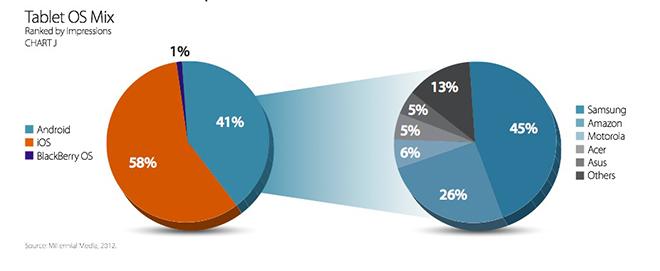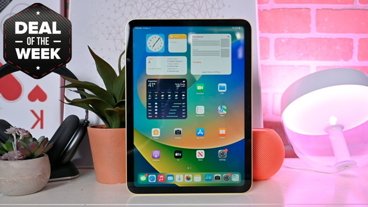Apple in 2012 increased its lead over other mobile device manufacturers in terms of mobile ad impressions, leveraging the launch of the iPad mini to grow its share to nearly a third of the overall market, according to a new statistics.
Millennial Media, the third-largest mobile advertising platform after Apple and Google, released on Friday its 2012 year in review report for the mobile advertising market, which places Apple atop all other manufacturers with 31.2% of all mobile-based ad impressions. That's nearly a five%age point increase over the company's 26.35% share in 2011.
More specifically, the report illustrates the increasing dominance of Apple and Samsung in the mobile sector. Samsung was second to Apple, with 22.32% of mobile impressions. Together, the two manufacturers combine for control for more than half of all mobile impressions.
The only other manufacturer with double-digit impression share was BlackBerry, with 11.5%.
Millennial affirmed that Apple's iOS continues to lead among tablet operating systems in the mobile ad space, generating 58% of all ad impressions. However, Android's share in the segment has grown to 41%. Samsung was the overall leader among Android tablet manufacturers, with 45% of ad impressions. Meanwhile, Kindle Fire maker Amazon took second place with 26%. Motorola, Acer, and Asus rounded out the top five Android tablet makers, though none of the three approached a 10% share.
Apple's iPhone and Samsung's Galaxy line of Android-powered devices have been driving the mobile industry for some time now. In 2011, Apple and Samsung accounted for about 43% of mobile ad impressions. The two companies' dominance of the mobile sector has come at the expense of other manufacturers. Nearly every other competitor lost ad impression share from 2011 to 2012.
Notably, Millennial's figures point to considerable sales for Apple's iPad mini. Apple's mid-sized tablet, from its introduction, saw ad impression growth at a rate of 28% per day, outpacing Amazon's Kindle Fire, which also sold briskly following its introduction. The report also identified considerable growth by Samsung's Galaxy Note II, which saw impressions rise at a rate of 20% per month following its release.
 Kevin Bostic
Kevin Bostic








-m.jpg)






 Malcolm Owen
Malcolm Owen
 William Gallagher
William Gallagher
 Charles Martin
Charles Martin
 Christine McKee
Christine McKee
 Wesley Hilliard
Wesley Hilliard

 Andrew Orr
Andrew Orr









3 Comments
[quote]Millennial Media, the third-largest mobile advertising platform after Apple and Google, released on Friday its 2012 year in review report for the mobile advertising market, which places Apple atop all other manufacturers with 31.2% of all mobile-based ad impressions. [/quote] Why not just explain in the first sentence that the data is meaningless (unless you're considering advertising on Millennial Media). First, it's a relatively minor portion of the entire business. Second, it's not representative. Since Apple advertisements only appear on iPhones, iPhones will be underrepresented in the total mix when you use a single ad source. Flip it around. If you choose to use Apple iAds for your data, the headline would read "iOS devices maintain 100% market share for 3rd consecutive year". SAMPLES MUST BE REPRESENTATIVE OF THE MARKET AS A WHOLE TO BE MEANINGFUL.
Why not just explain in the first sentence that the data is meaningless (unless you're considering advertising on Millennial Media).
Exactly. More than anything else, it tells us who uses apps from developers that show Millennial Media ads.
For example, the same report points out that their Android ad viewers (48%) far outnumber iOS ad viewers (32%).
And their recent special report noted that Gamers were represented by 64% Android to 30% iOS,
Similar ad reports have been used by bloggers to claim that iOS owners utilize their devices "more" than Android owners.
It's fairly meaningless whenever people try to pigeonhole various OS users by ad impressions. There's just too much missing information. For example, what ratio of iOS developers use MM ads instead of iAds?
A metric is a metric. They are all skewed in some way and include or lack data points of some sort that some deem relevant and others do not. Depends what side of the fence you are most of the time. This is just another way of saying the mobile device market is increasingly becoming a 2 horse race with one innovator and one duplicator.